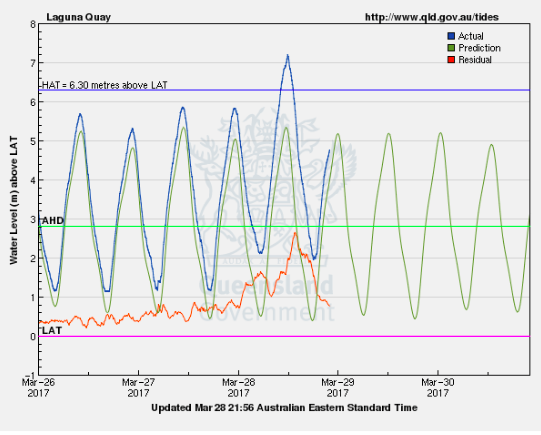Tropical Cyclone Debbie made landfall along the Queensland coast Tuesday as a category-4 cyclone on the Australian cyclone wind scale. Debbie produced maximum sustained winds of around 175 km/ hr (110 mph), which would place it at the threshold of a category 3 hurricane in the Atlantic.
Debbie generated substantial coastal flooding for areas east and south of Bowen. Photographs coming from the impacted area have depicted storm surge and large waves pounding coastal buildings on Hamilton Island.
Storm surge and waves pound a building on the coast of Hamilton Island, Queensland, on Tue Mar 28. Photo: http://www.abc.net.au/news/2017-03-28/cyclone-debbie-bom-before-after-hamilton-island-photos/8393164
Near Midge Point, photographs depict compound flooding from storm surge and heavy rain, without the presence of wave action. Witnesses on the ground have reported around 1 m (3.3 ft) of water above ground level, inundating buildings in the town. The region from Midge Point to Conway has a harbor that is open to the southeast, enabling prolonged winds to pile up storm surge in this region.
Compound storm surge and rainfall flooding in Midge Point, Queensland, on Tue Mar 28, 2017. Local reports indicated 1 m (3.3 ft) of water above ground level. Photo submitted by Jodi Lorraway of Proserpine.
Compound storm surge and rainfall flooding in Midge Point, Queensland, on Tue Mar 28, 2017. Local reports indicated 1 m (3.3 ft) of water above ground level. Photo submitted by Jodi Lorraway of Proserpine.
Storm surge levels exceeded 1 m (3.3 ft) above normal astronomical tides from Shute Harbour to Mackay. The highest recorded water level was 2.75 m (9 ft) at Laguna Quays, however, higher water marks may be found after the storm subsides and coastal surveys are conducted.
Storm surge levels exceeded 1 m (3.3 ft) from Shute Harbour to Mackay, with the highest recorded levels coming from Laguna Quays, where the storm surge reached around 2.75 m (9 ft).
Unfortunately, the peak storm surge for many locations occurred near the time of high tide, enabling total water levels to exceed Highest Astronomical Tide (HAT). HAT represents the highest high tide under "normal" (non-storm) conditions, taking into account astronomical tide levels.
This was due, in part, to Debbie's slow forward speed, which enabled high water to persist for more than one day, ensuring high storm surge would occur near the time of high tide. Locals on the ground reported that one of the major differences between Debbie and Tropical Cyclone Ului, in 2010, was that Debbie's wind and storm surge lasted noticeably longer.
At Laguna Quays, the 2.75 m (9 ft) storm surge occurred near the time of high tide, enabling total water level (storm surge + tide) to exceed HAT by around 80 cm (2.6 ft).
Water level graph for Laguna Quays, Queensland. The orange line depicts storm surge (height above normal astronomical tide), while the blue line represents total water level, including tides. Source: https://www.qld.gov.au/environment/coasts-waterways/beach/storm-sites/laguna-quays/
Debbie generated the highest storm surge in Queensland since Tropical Cyclone Yasi produced a 5.33-m (17.5 ft) surge in 2011. According to the U-Surge Project, Debbie generated the 14th highest storm surge in Queensland since 1880, or a storm surge level that should only be expected approximately every 10 years in that state.
Tropical Cyclone Debbie generated a storm surge of 2.75 m (9 ft) at Laguna Quays, Queensland. This is the 14th highest recorded storm surge in Queensland since 1880.













